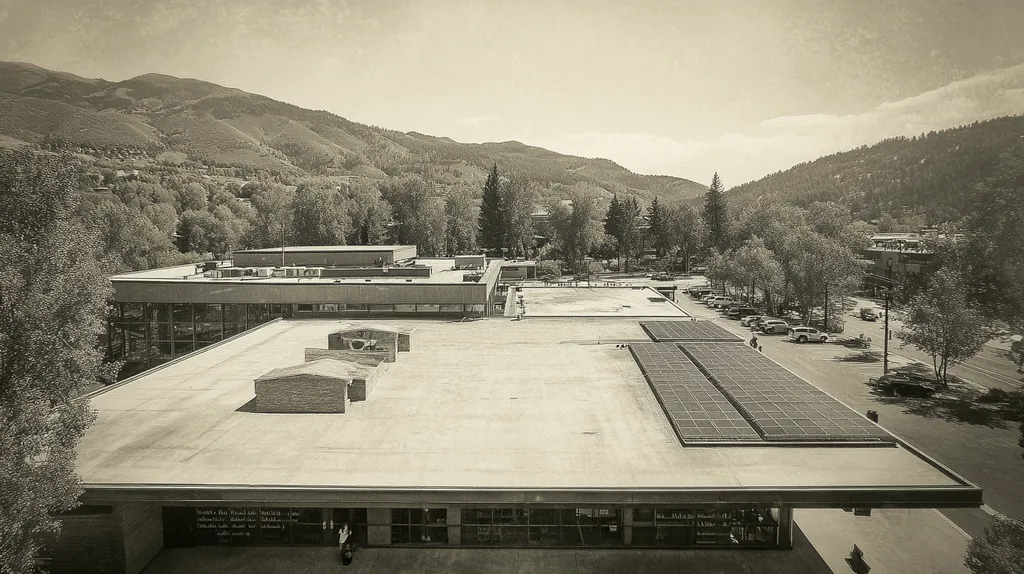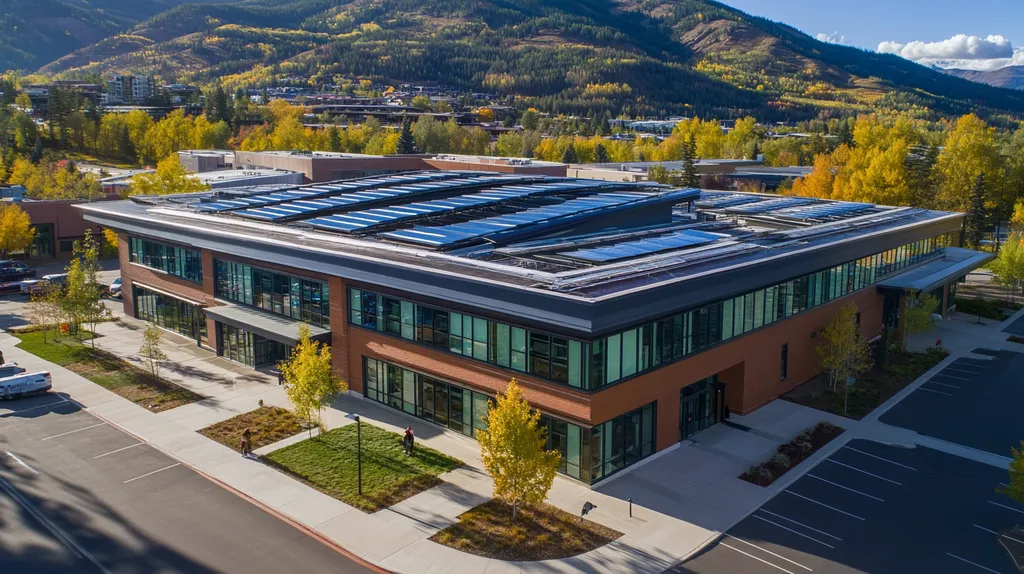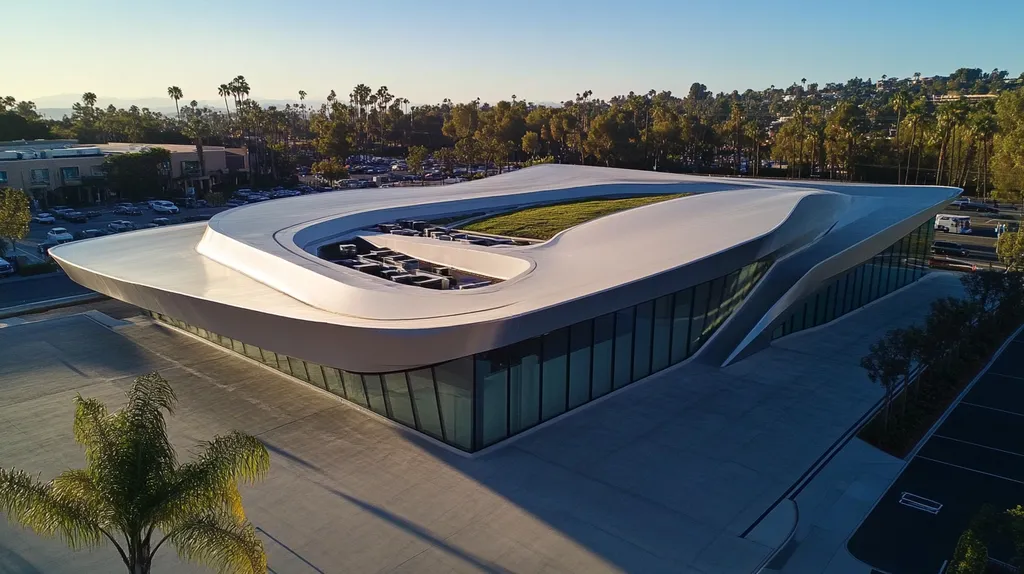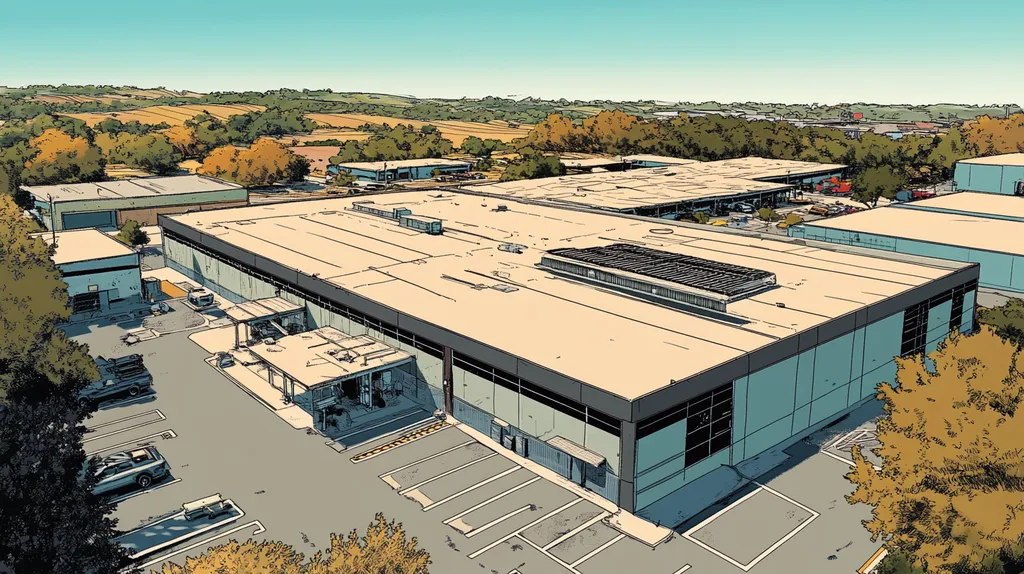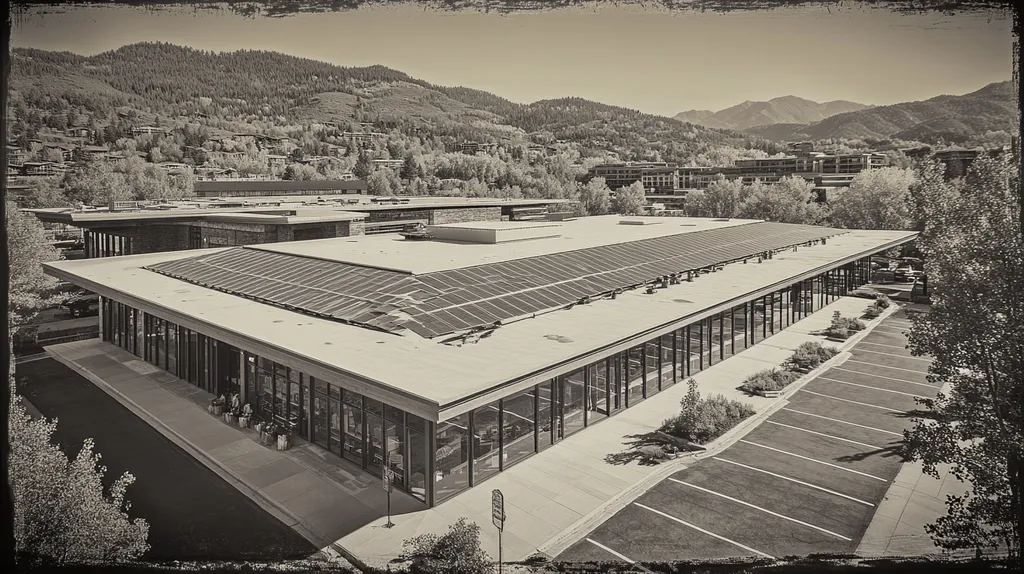Every year, poorly designed commercial roofs cost businesses over $2.5 billion in repairs, energy waste, and structural damage. Modern roof design has evolved far beyond simple weather protection into a critical component of building performance and sustainability.
Today’s commercial roofing systems must integrate structural integrity, energy efficiency, and long-term durability to meet increasingly demanding building codes and environmental standards.
This comprehensive guide examines the essential elements of enhanced commercial roof design, from material selection and system integration to preventive maintenance and performance optimization.
SECTION 1: THE BASICS EXPLAINED
Commercial roof design has evolved far beyond simple weather protection into a critical component of building performance and sustainability. Studies show that inadequate roof designs can reduce building efficiency by up to 40% while increasing maintenance costs significantly. Today’s commercial roofing must integrate structural integrity, energy efficiency, and long-term durability to meet increasingly demanding building codes and environmental standards.
What It Is (In Plain Language)
Commercial roof design encompasses the complete system of components working together to protect and enhance a building’s performance. This includes the structural deck, insulation layers, waterproofing membranes, and drainage systems.
The structural deck must be engineered to resist various loads and wind pressures while supporting all roofing components above it. (source: IBHS)
Modern designs incorporate multiple protective layers, each serving specific functions. These include moisture barriers, thermal insulation, and weatherproof coverings that work together as an integrated system.
The design process also accounts for local climate conditions, building use patterns, and energy efficiency goals. These factors determine material choices and system configurations.
Why It Matters (To Your Building)
A well-designed roof directly impacts operational costs through improved energy efficiency and reduced maintenance needs. Proper insulation and reflective materials can cut cooling costs by 15-30% in warm climates.
Building durability depends heavily on roof performance. Water infiltration from poor design can damage structural elements, equipment, and inventory, leading to costly repairs and business interruptions.
Modern roof designs also affect property value and marketability. Energy-efficient systems can qualify buildings for green certifications and utility incentives, making them more attractive to tenants and buyers.
Insurance costs often reflect roof quality, with superior designs qualifying for lower premiums due to reduced risk of weather-related damage.
How It Works
Commercial roof systems function through carefully engineered layers that manage water, heat, and air movement. The outer layer shields against UV rays and precipitation while channeling water to drainage points.
Beneath the surface, insulation layers control heat transfer between the building interior and exterior. Proper placement and thickness of these materials significantly impact HVAC efficiency.
Ventilation systems within the roof assembly help regulate temperature and moisture levels. This prevents condensation buildup that could compromise structural integrity and insulation performance.
Modern designs often incorporate smart monitoring systems that detect potential issues before they become major problems, enabling proactive maintenance and extending roof life.
SECTION 2: PRACTICAL APPLICATIONS
Every commercial roof represents a critical investment that directly impacts building performance and operational costs. Studies show that roof-related issues account for over 40% of building maintenance expenses, while proper design can reduce energy costs by up to 25%. Understanding practical applications helps owners maximize their return on investment through strategic implementation, proper timing, and system integration.
Common Uses & Examples
Modern commercial roofing systems serve multiple functions beyond basic weather protection. The latest designs incorporate energy-efficient materials, sustainable features, and smart monitoring capabilities to enhance building performance.
Reflective membranes and cool roofing technologies have become standard in warm climates, reducing cooling loads by up to 30%. These systems work alongside proper insulation to create an effective thermal barrier.
Green roof installations are gaining popularity in urban areas, providing stormwater management while creating usable outdoor spaces. These systems can retain up to 70% of rainfall, reducing drainage system loads.
Solar-ready roof designs now accommodate renewable energy installations without compromising waterproofing integrity. Proper integration of mounting systems and electrical conduits during initial design prevents future complications.
When You Need It Most
Commercial roofs are addressed in terms of both roof covers and roof-mounted equipment, with specific recommendations for low-sloped and steep-sloped applications. Building owners should evaluate their roofing systems during key transition points to maximize investment value. (source: IBHS)
Major renovations present ideal opportunities to upgrade roofing systems, as concurrent work can reduce overall project costs. This timing allows for comprehensive improvements without disrupting occupants multiple times.
Seasonal transitions demand thorough inspections to identify potential weaknesses before severe weather hits. Spring assessments can reveal winter damage, while fall inspections prepare systems for cold weather challenges.
Equipment upgrades or replacements should trigger roofing system evaluations to ensure proper integration and protection. This prevents retrofit complications and maintains warranty coverage.
Interactions With Other Systems
Commercial roofs must work in harmony with multiple building systems to achieve optimal performance. HVAC equipment placement affects both energy efficiency and structural loading, requiring careful coordination during design and installation.
Drainage systems integrate directly with building plumbing and site stormwater management. Proper sizing and placement of drains, scuppers, and downspouts prevents water accumulation and structural stress.
Electrical systems for lighting, monitoring equipment, and solar installations need secure pathways through the roofing assembly. Careful detailing at penetration points maintains system integrity while supporting modern building technologies.
Fire suppression systems often require roof access and support structures. These elements must be incorporated without compromising the roof’s primary waterproofing and insulation functions.
SECTION 3: KEY TERMINOLOGY DECODED
Clear understanding of roofing terminology directly impacts project success and building performance. Studies show that terminology confusion leads to 23% of commercial roofing failures and over $2.5 billion in annual repair costs. Low-slope commercial roofs require precise understanding of specialized terms, as even minor misinterpretations can compromise drainage, thermal performance, and structural integrity.
Essential Terms Explained
Low-slope roofs, defined as having less than a 3:12 pitch, form the foundation of commercial roofing terminology. These systems require specific design approaches to ensure proper drainage and weatherproofing performance. (source: Amber Book)
R-value measures insulation effectiveness, with higher numbers indicating better thermal resistance. Commercial roofs typically require R-values between R-20 and R-40, depending on climate zone and building use.
Membrane systems serve as the primary waterproofing layer, available in thermoplastic (TPO/PVC) or thermoset (EPDM) materials. Selection impacts durability, energy efficiency, and maintenance requirements over the roof’s lifespan.
Load calculations encompass dead loads (permanent weight), live loads (temporary weight), and wind uplift forces. Understanding these terms ensures proper structural support and attachment methods.
Industry Jargon Translated
Thermal bridging occurs when heat bypasses insulation through metal fasteners or gaps. This phenomenon can reduce overall roof system efficiency by up to 40% if not properly addressed.
Cool roof ratings measure solar reflectance and thermal emittance on a scale of 0 to 1. Higher numbers indicate better heat reflection, directly impacting building cooling costs.
Positive drainage refers to roof slope configurations that eliminate standing water within 48 hours. This requirement prevents membrane degradation and structural stress from ponding.
Vapor retarders control moisture migration through the roof assembly. Their placement and necessity depend on interior humidity levels and local climate conditions.
Measurement & Units Simplified
Square footage calculations include both horizontal area and vertical surfaces like parapets. One roofing “square” equals 100 square feet, serving as the standard unit for material ordering.
Wind uplift resistance is measured in pounds per square foot (psf). Edge zones require higher resistance values, often 50% greater than field areas.
Membrane thickness is measured in mils (thousandths of an inch). Common specifications range from 45 to 80 mils, affecting durability and puncture resistance.
Slope measurements use ratio notation, such as 1:12, indicating one foot of rise per twelve feet of run. Minimum slopes for drainage typically start at ¼:12 for most commercial applications.
SECTION 4: DECISION FACTORS
Making informed choices about commercial roofing systems directly impacts building performance and financial outcomes. Industry data shows that poor roofing decisions lead to 35% higher operating costs and can reduce building asset value by up to 25%. Beyond initial costs, decision-makers must evaluate performance capabilities, durability factors, and long-term maintenance requirements to optimize their investment and protect their facilities.
Cost Considerations
Initial costs represent only 15-20% of total roofing expenditure over a building’s lifetime. Smart investments in quality materials and proper installation can reduce long-term expenses by 40% or more through decreased maintenance and repair needs.
Energy efficiency features like enhanced insulation and reflective membranes typically add 10-15% to upfront costs. However, these elements can reduce HVAC operating expenses by 25-30% annually, providing rapid return on investment.
Maintenance costs vary significantly based on system design and material quality. Premium systems may cost 20-30% more initially but require only minimal annual maintenance, while budget systems often need extensive repairs by year five.
Life-cycle cost analysis should include removal and disposal expenses, which can reach $3-5 per square foot for conventional systems. Sustainable designs may cost more upfront but offer reduced disposal costs and potential recycling credits.
Performance Trade-offs
Material selection impacts multiple performance factors including weather resistance, energy efficiency, and structural loading. Single-ply membranes offer excellent waterproofing but may require additional protection against punctures and UV exposure.
Insulation thickness affects both thermal performance and overall system height. While thicker insulation improves energy efficiency, it may require parapet modifications or compromise roof access points.
Drainage design balances water removal capacity against installation complexity. Internal drains provide efficient water management but require more maintenance than external systems.
Equipment mounting and penetration details influence system reliability. Robust mounting solutions cost more initially but prevent leaks and extend roof life by maintaining membrane integrity.
Lifespan & Durability Factors
System longevity depends heavily on material quality and installation expertise. Premium systems typically last 25-30 years with proper maintenance, while economy options may require replacement within 12-15 years.
Environmental exposure significantly impacts durability. UV radiation, temperature extremes, and chemical pollutants can reduce material lifespan by 20-30% without proper protection layers.
Structural movement and building vibration stress roofing components over time. Enhanced attachment methods and expansion provisions add cost but prevent premature failure in dynamic conditions.
Regular inspection and preventive maintenance programs extend system life by identifying issues before they cause significant damage. Professional maintenance typically costs 1-2% of installation price annually but can double roof lifespan.
SECTION 5: COMMON CHALLENGES
Commercial roofing systems face constant threats that can compromise building performance and safety. Studies reveal that up to 80% of commercial roofs require premature replacement due to preventable issues, costing businesses billions annually in repairs and lost productivity. Understanding and addressing these challenges proactively can significantly extend roof lifespan while protecting valuable assets and operations beneath.
Frequent Problems & Solutions
A commercial roof that is well-designed and properly installed should provide many years of protection from weather elements, while delivering appropriate insulation and energy savings through proper coloring and materials. However, poor design, code violations, and subpar installation practices frequently undermine these benefits. (source: Simon Roofing)
Moisture infiltration remains the leading cause of roof failure, often entering through compromised flashings or membrane seams. Regular inspection and maintenance of these critical areas can prevent costly structural damage and interior disruptions.
Poor drainage design creates ponding water that accelerates membrane deterioration and increases structural loads. Installing additional drains or adjusting slope can resolve persistent standing water issues.
Mechanical equipment damage from foot traffic and maintenance activities frequently compromises roof integrity. Establishing designated walkways and equipment access points protects vulnerable areas while maintaining necessary serviceability.
Warning Signs To Watch For
Interior water stains or drips indicate active leaks that require immediate investigation. Even minor leaks can mask significant hidden damage that worsens over time.
Membrane blistering, splitting, or surface deterioration signals material failure that can quickly spread. Early detection through routine inspections enables targeted repairs before system-wide replacement becomes necessary.
Excessive energy costs often indicate compromised insulation or air leakage through the roof assembly. Thermal imaging can pinpoint these inefficiencies for targeted improvements.
Visible sagging or deflection may indicate structural concerns from water accumulation or overloading. Professional evaluation can determine if immediate intervention is needed.
Preventative Approaches
Implementing a documented maintenance program with scheduled inspections forms the foundation of roof protection. This should include cleaning drains, checking seams, and examining flashings at least quarterly.
Staff training enables early problem identification and appropriate response protocols. Simple visual inspections can catch developing issues before they become emergencies.
Proper record-keeping of all roof activities, including repairs and modifications, helps track system performance and warranty compliance. This documentation proves invaluable when planning future improvements or addressing problems.
Installing monitoring systems can provide early warning of moisture infiltration or unusual conditions. Modern sensors detect problems invisible to visual inspection, enabling truly proactive maintenance.
SECTION 6: NEXT STEPS & RESOURCES
Strategic decisions about commercial roofing directly impact building performance, operational costs, and asset value. Research shows that over 40% of roof failures stem from inadequate planning and poor provider selection in the initial stages. By following industry-proven evaluation methods and leveraging available resources, property owners can avoid costly mistakes while maximizing their roofing investment’s long-term value.
Questions To Ask Providers
Start by verifying the provider’s experience with your specific building type and roofing system. Request detailed case studies of similar projects, including performance data and photos of installations at least five years old.
Demand transparency about material specifications, installation methods, and quality control procedures. Professional contractors should readily explain their approach to critical details like flashings, penetrations, and drainage components.
Discuss maintenance requirements and lifecycle costs beyond the initial installation. Quality providers offer detailed maintenance plans and can demonstrate how their system choices impact long-term performance and operating costs.
Review warranty terms carefully, focusing on coverage scope and exclusions. The best providers explain exactly what is and isn’t covered, including response times for service calls and repair protocols.
Industry Standards & Guidelines
Key reference standards include ASTM testing protocols for materials, FM Global requirements for wind resistance, and UL classifications for fire safety. These provide measurable benchmarks for evaluating system performance.
Local building codes establish minimum requirements for thermal resistance, drainage, and structural capacity. Work with providers who demonstrate thorough knowledge of current code requirements and upcoming changes.
Industry associations like NRCA publish detailed technical manuals covering best practices for various system types. These resources help owners verify that proposed solutions align with established guidelines.
Sustainable design standards such as LEED provide frameworks for evaluating environmental performance. Understanding these criteria helps optimize system selection for both operational efficiency and certification goals.
Further Learning Simplified
Take advantage of manufacturer training programs and technical bulletins that explain system components and installation requirements. These resources often include detailed drawings and specifications that clarify proper construction methods.
Professional organizations offer online courses covering roof system selection, maintenance procedures, and emerging technologies. Many provide continuing education credits while building practical knowledge.
Industry trade shows and conferences showcase new products and installation techniques. These events provide opportunities to evaluate multiple solutions and connect with experienced professionals.
Digital tools like energy modeling software and lifecycle cost calculators help quantify system performance. Learning to use these resources enables more informed decision-making about roofing investments.
The Bottom Line
With commercial roofing failures costing businesses over $2.5 billion annually, implementing proper design principles has never been more critical for building performance and protection.
Modern commercial roofs must integrate multiple systems while balancing durability, energy efficiency, and maintenance requirements to deliver optimal returns on investment.
Success requires understanding key terminology, evaluating decision factors carefully, and implementing preventive maintenance strategies that extend system life.
By following industry standards, leveraging professional expertise, and utilizing available resources, property owners can develop roofing solutions that protect their facilities while reducing operational costs for decades to come.
The future of commercial roofing lies in smart, sustainable designs that maximize both building performance and long-term value.
FREQUENTLY ASKED QUESTIONS
Q. What is a commercial roof design?
A. Commercial roof design is a system of components working together to protect buildings. It includes structural decks, insulation, waterproof membranes, and drainage systems, ensuring energy efficiency and durability.
Q. How can a commercial roof reduce energy costs?
A. A well-designed roof can significantly decrease energy costs by using reflective materials and proper insulation. Features like cool roofs can lower cooling loads by 25%, resulting in lower utility expenses.
Q. What are common materials used for an industrial roof?
A. Common materials for industrial roofs include single-ply membranes (TPO, PVC, EPDM) and built-up systems. Each material has unique benefits regarding durability, energy efficiency, and maintenance needs.
Q. What should I consider when choosing a commercial roofing provider?
A. Consider the provider’s experience with similar projects, material quality, and installation methods. Transparency about costs, maintenance plans, and warranties is crucial for ensuring a successful outcome.
Q. How often should I inspect my commercial roof?
A. Commercial roofs should be inspected at least twice a year and after severe weather. Regular assessments help identify early signs of damage, allowing proactive maintenance to extend the roof’s lifespan.
Q. What are the benefits of energy-efficient roofing systems?
A. Energy-efficient roofing systems lower energy costs, enhance indoor comfort, and can often qualify for tax credits and rebates. They also contribute to sustainability by reducing environmental impact and energy use.
Q. How do I know if my roof needs replacement or repair?
A. Signs that your roof may need replacement include extensive water damage, frequent leaks, or significant wear and tear. Consulting a professional can help assess the situation and recommend the best course of action.

